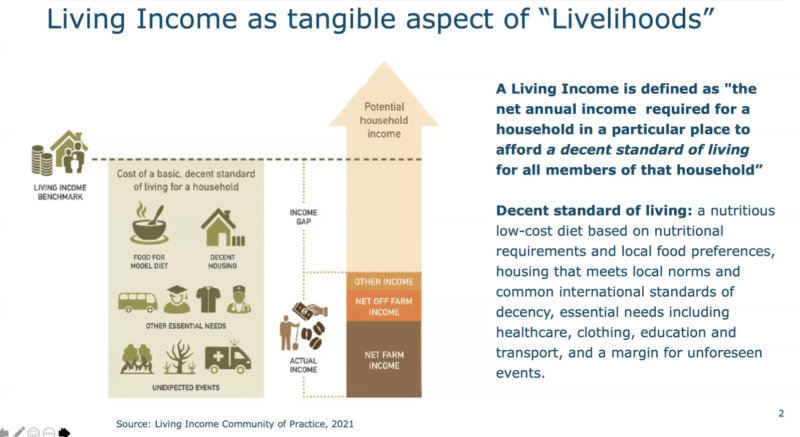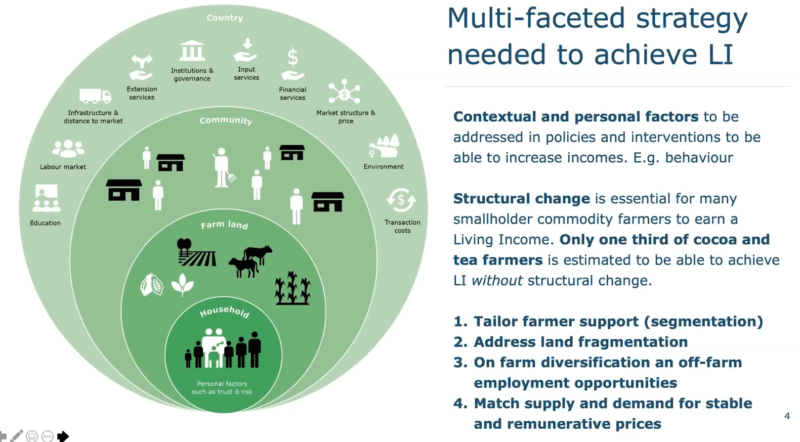Social and Economic Equity in the Botanical Industry
We have recently hosted a series of conversations on social and economic equity in the botanical industry. I’ve also been actively engaged in learning more about initiatives focusing on addressing the living income gap in other industries, especially those led by the Living Income Community of Practice. Our goal in these conversations is to develop a strategy for how to approach the living income gap in the botanical sector.
Below are some highlights about living income from the discussion, both about the concept as well as the role of certifications in addressing economic inequity in sourcing botanicals. It is well worth watching the complete recording of the webinar to understand the nuance and complexity of these issues. There are no simple answers, but the first step is addressing the issue and these speakers do an excellent job laying out that complexity.
What’s a Living Income?
Basically, living income is an assessment of what a household needs to earn from all income sources to have a decent standard of living. A decent standard of living includes: food for a healthy diet, decent housing, money for essential needs such as clothing, travel, education for children, and a margin for unforeseen events such as health care needs or an unexpected crisis. The living income concept, as Yuca Waarts, senior researcher sustainable value chains at Wageningen University in the Netherlands, explains in the recent SHP webinar, helps provide a tangible way to see and measure how people are doing and to begin to identify what needs to be done to improve. To learn more about the concept and how to measure it, visit the Living Income Community of Practice website.

The Income Gap
This information is gathered from benchmarks that are available on sites such as Align or the Global Living Wage Coalition and are based on region. These benchmarks are then set against the income – which is challenging to measure in any sector and especially so in the botanical sector where one farmer or collector will likely be growing or collecting a number of different species at different times of the year. The income gap, the space between a living income and the amount earned, is where you then want to work to improve farmer and collector livelihoods.
Yuca shared examples from her research on the impacts of interventions such as certifications on the cocoa sectors in Ghana and the Ivory Coast, and on smallholder tea farmers in Kenya. They expected there would be a gap in income. Even so, they were shocked to see how few farmers were getting a living income, even with certifications.

Some of the main reasons for this gap was the size of farms and limited opportunities for off farm income. Low prices are also a contributor to gaps in attaining a living wage. But it is not simply a matter of increasing prices, since that can disrupt the market in unintended ways. Stability of prices also matters for the economic stability of an ingredient.
The Importance of Gathering Data
Yuca’s presentation highlighted the importance of gathering data on who the farmers are to begin targeting solutions so that interventions are more likely to succeed. For farmers with large enough land holdings, interventions like certifications can make a difference in closing that gap. But for farmers with insufficient land, structural changes are needed to begin to make any concrete changes in income and livelihood. For those changes, there must be collaboration and cooperation between the public and private sectors, since no single party can solve all of the problems.

Certifications on the Ground: The Challenges and Opportunities
In the 1 minute clips below, Kevin Casey, Co-founder and CEO of Banyan Botanicals, and Jan Von Enden, Head of Group Sustainability – Supply Chains at Martin Bauer Group, share their perspectives on why certifications are a key strategy in addressing economic inequities on the ground, six steps on the path to sustainability, and the business and ethical cases for sustainability. In the full webinar, they offered steps that they are each taking to address some of the complex issues Yuca raised.
[envira-gallery id=”8499″]
